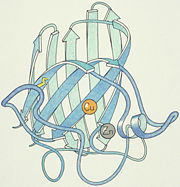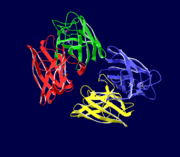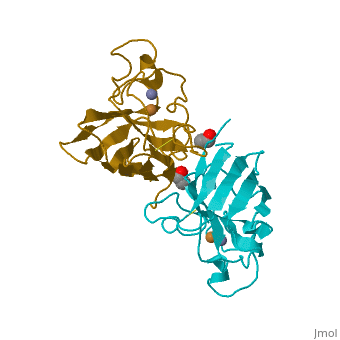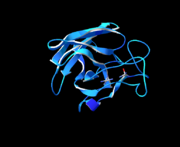Copper, Zinc Superoxide Dismutase
From Proteopedia
Copper, zinc superoxide dismutase (or Cu,Zn SOD) is an oxidoreductase enzyme responsible for the very rapid two-step dismutation of the toxic superoxide radical to molecular oxygen and hydrogen peroxide through alternate reduction and oxidation of the active-site copper[1].
Contents |
Introduction
Oxygen is vital to sustain life; it serves as the final electron acceptor in the electron transport chain, allowing us to produce a large amount of energy from our food. But oxygen is also a dangerous compound.[2]. Reactive forms of oxygen, such as superoxide, leak from the respiratory chain and wreak havoc on the cell. Superoxide is a free radical, a molecule that readily accepts electrons, which make them highly reactive. They can strip electrons from cellular molecules essential for proper cell function, causing dysfunction and possibly resulting in cell death. Cu, Zn superoxide dismutase is an important antioxidant defense in nearly all cells exposed to oxygen. It forms a crucial component of the cellular response to oxidative stress by detoxifying the superoxide radical via a special reaction known as dismutation [3].
Superoxide Dismutase Family
Cu, Zn superoxide dimustase belongs to the family of oxidoreductasesknown as Superoxide Dismutase (SOD). In mammals there are three known isozymes of SOD. The cytosolic and extracellular enzymes,both containing Cu, Zn as their active sites and the mitochondrial enzyme contains Mn at its active site[4].
General Structure
Cu, Zn SOD is a metalloprotein with a structural weight of 62913.70, containing both copper and zinc ions in each subunit, each enzyme subunit is composed primarily of eight antiparallel β strands that form a flattened cylinder, plus three external loops. The largest loop includes both a disulfide region and a Zn-ligand region, each of which resembles one of the other two loops in overall structure. The second largest loop includes a short section of α helix and the smallest loop forms a Greek key connection across one end of the β barrel. The single disulfide bond, which forms a left-handed spiral, covalently joins the largest loop to the beginning of β strand 8. Symmetrically related β bulge pairs fold the two large loops back against the external surface of the β barrel to surround the active channel. The active site Cu(II) and Zn(II) lie 6.3 Å apart at the bottom of this long channel; the Zn is buried, while the Cu is solvent-accessible. The side-chain of His61 forms a bridge between the Cu and Zn and is coplanar with them within the current accuracy of the data. The Cu ligands ND1 of His44 and NE2 of His46, −61 and −118 show an uneven tetrahedral distortion from a square plane. The protein was solved from X-Ray difraction with 2.0Å[5].
The Reaction of Dismutase
|
Dismutation is a term that refers to a special type of reaction, where two equal but opposite reactions occur on two separate molecules [2].
Superoxide is produced both accidentally and also as a reactive oxygen species required for a number of enzyme-catalyzed reactions. Cu, Zn SOD catalyzes the reaction between superoxide and water to yield oxygen and hydrogen peroxide. Most enzymes that produce and require superoxide are in the peroxisomes, together with superoxide dismutase, catalase and peroxidases[6]. Cu, Zn SOD takes two molecules of superoxide, strips the extra electron off of one, and places it on the other. So, one ends up with an electron less, forming normal oxygen, and the other ends up with an extra electron. The one with the extra electron then rapidly picks up two hydrogen ions to form hydrogen peroxide.
![]()
However, hydrogen peroxide is also dangerous and needs to be detoxified. The cells use the enzyme catalase, a ubiquitous heme protein that catalyzes the dismutationof hydrogen peroxide into water and molecular oxygen[7].
2H2O2 → 2H2O + O2
Oxidative Capabilities and Importance of Vitamins
Free radicals such as superoxide are a type of reactive oxygen species that can strip electrons from proteins, lipids, or nucleic acids, thereby destroying their function and resulting in cell dysfunction or death. They are highly reactive molecules with an unpaiared electron in an outer orbital, which can initiate chain reactions by removal of an electron from another molecule to complete its own orbital[4]. If SOD is defective, superoxide is not degraded and can destroy cells. Motor neurons appear to be particularly sensitive to superoxide attack. Mutations in human Cu, Zn SOD are associated with the development of familial amyotrophic lateral sclerosis (motor neuron disease)[3]. Over 130 mutations to copper, zinc superoxide dismutase (SOD) are implicated in the selective death of motor neurons found in 25% of familial amyotrophic lateral sclerosis (ALS) patients. ALS is an adult onset disease involving the progressive death of lower motor neurons in the spinal cord and upper motor neurons in the brain stem and cortex[8]
Free radicals can react and alter the structure of molecules that control the normal cell function of the cell. According to the free radical theory, this damage can accumulate with age, leading to the normals symptoms seen with aging. Antioxidants, such as beta carotene, vitamin C, and vitamin E, can donate electrons to free radicals, without themselves becoming harmful. Thus, antioxidants may prevent the damage caused by free radicals and may ward off age-related disorders, ranging from wrinkles to cancer. Experiments designed to test this hypothesis, however, have not consistently produced positive results[9]
Current studies are showing one of the long-term benefits of exercise may be by increasing the amount of superoxide SOD in the cell. The elevated aerobic metabolism during exercise causes more ROS to be generated. In response, the cell synthesizes more protective enzymes with a protective net effect, because the increase in SOD more effectively protects the cell during periods of rest [7].
3D structures of Cu-Zn superoxide dismutase
See Also
- Free-Radical Theory of Aging (FRTA)
- Structural characterization of zinc-deficient human superoxide dismutase and implications for ALS
References
- ↑ Tainer JA, Getzoff ED, Richardson JS, Richardson DC. Structure and mechanism of copper, zinc superoxide dismutase. Nature. 1983 Nov 17-23;306(5940):284-7. PMID:6316150
- ↑ 2.0 2.1 RCSB Protein Data Bank.(2007). http://www.rcsb.org/pdb/static.do?p=education_discussion/molecule_of_the_month/pdb94_1.html
- ↑ 3.0 3.1 Hough MA, Hasnain SS. Structure of fully reduced bovine copper zinc superoxide dismutase at 1.15 A. Structure. 2003 Aug;11(8):937-46. PMID:12906825
- ↑ 4.0 4.1 Devlin, Thomas M. (2006). Textbook of Biochemistry with Clinical Correlations 6th Ed. Wiley-Liss, Hoboken NJ. p.574
- ↑ Tainer JA, Getzoff ED, Beem KM, Richardson JS, Richardson DC. Determination and analysis of the 2 A-structure of copper, zinc superoxide dismutase. J Mol Biol. 1982 Sep 15;160(2):181-217. PMID:7175933
- ↑ Murray, R., Bender, D., Botham, K. Kennelly, P. Rodwell, V. Weil, P. (2006). Harper's Illustrated Biohemistry. 28th Ed. McGraw Hill. p.484-485
- ↑ 7.0 7.1 Berg, J. Tymoczko, J. Stryer, L. (2007). Biochemistry 6th Ed. W.H. Freeman and Company, NY. p.518-519
- ↑ Roberts BR, Tainer JA, Getzoff ED, Malencik DA, Anderson SR, Bomben VC, Meyers KR, Karplus PA, Beckman JS. Structural characterization of zinc-deficient human superoxide dismutase and implications for ALS. J Mol Biol. 2007 Nov 2;373(4):877-90. Epub 2007 Aug 2. PMID:17888947 doi:http://dx.doi.org/10.1016/j.jmb.2007.07.043
- ↑ Seeley, R.R, Stephens, T.D, Tate, P. (2008). Anatomy & Physiology (8th ed.). New York, NY: McGraw Hill
Proteopedia Page Contributors and Editors (what is this?)
Jordan Schibli, Jane S. Richardson, David Canner, Michal Harel, Andrea Gorrell




